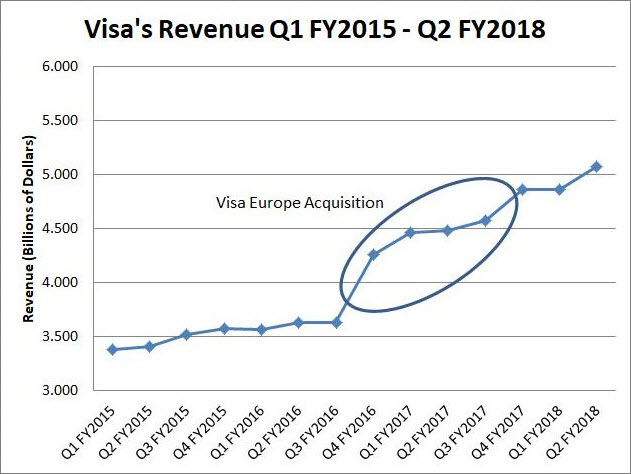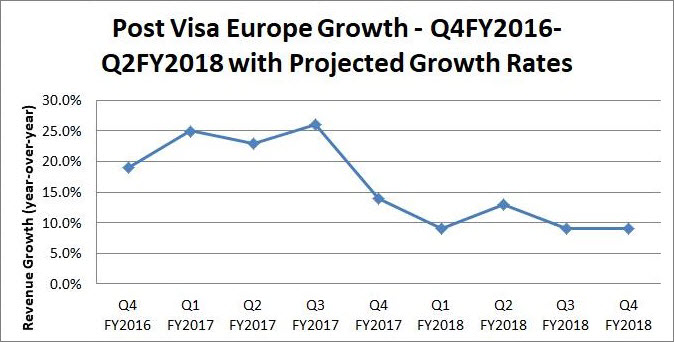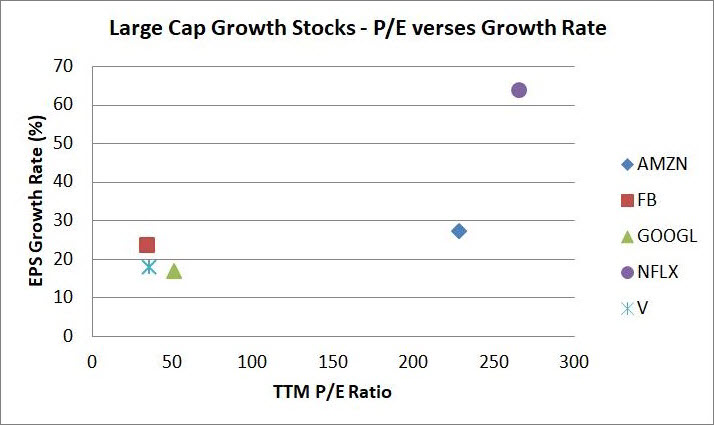Visa Inc. (NYSE:V) continues to deliver phenomenal shareholder returns year after year, and thus far 2018 is no exception. Over the past year, Visa has appreciated 45% and currently sits at a 52-week high. Visa has become a top-performing perineal large-cap growth stock that continues to deliver despite emerging threats in the digital payments space, blockchain technology and maturing markets in the traditional payments space leading to slower growth prospects. I’ve been reluctant to get behind the stock of Visa considering its valuation, slowing growth and trends away from the traditional credit card space among the younger demographics that embrace PayPal (PYPL) and PayPal’s Venmo for payment options and exchanging payments between multiple parties.
Furthermore, Amazon (AMZN) may be disrupting the credit card transaction space with its potential launch of Amazon financial services and Amazon Pay. Despite Visa’s massive move over the past year, growth has become worrisome and touched down to single digits before bouncing back to double digits over the last two quarters. I feel that shareholders have become overly enthusiastic about Visa’s growth prospects. The stock has appreciated over 45% during the past year, boasts a P/E of over 35 and a PEG of over 2.0 in the midst of a frothy market. This scenario doesn’t provide a great benefit-reward profile at these levels in my opinion.
Pay Pal Interview and Emerging Threat
PayPal has been a growing threat over the years, and Jim Cramer interviewed PayPal’s CEO Dan Schulman on Mad Money regarding the prospects and future of the payments space as he sees it, domestically and internationally.
"The entire financial systems' ecosystem is moving more rapidly than ever before away from cash and towards digital payments because of the explosion of mobile phones."
"If you look at markets like China or India, India really going through demonetization right now, they never really had point of sale terminals, credit card and what they're trying to do now is do everything through digital"
"When you go through digital its's a more efficient system, there aren't middlemen in-between to take part of the transaction and there's less corruption."
"For government benefits, there's much less leakage if it can go directly from the government right into a digital wallet of the consumer."
"You're seeing leapfrogs over what were credit card infrastructure or checking."
- PayPal’s CEO Dan Schulman
"Nothing against Mastercard (MA) and Visa, they're still great growth stocks, but the growth of the future is yours [Pay Pal]."
- Jim Cramer
This interview sheds light on the potential pivot away from credit card infrastructure to digital payments and money management in the digital age, particularly in India and China. PayPal has witnessed explosive growth in the digital payments space and peer-to-peer money management and transfer via its Venmo platform.
Potential Blockchain Disruption and Key Opinion Leaders
Another huge potential disruption in the credit card transaction space lies in blockchain technology that underpins the cryptocurrency markets. This technology applies to enterprise applications using its decentralized database, open ledger, and incorruptible transactional capabilities. Financial intuitions are already engaging in pilot programs to migrate away from traditional networks like Visa’s. American Express, for example, is exploring this technology with Ripple’s blockchain technology. Visa has a partnership with BTL Group (BTLLF) and IBM (IBM) exploring this superior technology for potential use. IBM is aggressively stepping into the enterprise blockchain solutions space as well.
“What the internet did for communications, blockchain will do for trusted transactions.”
— Ginni Rometty, CEO IBM
Google (GOOG), Facebook (FB), NVIDIA (NVDA), JP Morgan (JPM), Alibaba (BABA) and other big movers in technology are pivoting towards blockchain to harness its power to augment their respective business for the future. CEOs across a broad range of industries are investing heavily in blockchain. Global spending on blockchain solutions is set to more than double to $2.1 billion this year per a Cowen report.
Facebook made a major executive move to support its blockchain efforts where the head of its Messenger platform, a board member at cryptocurrency exchange Coinbase and former CEO of PayPal, David Marcus is “setting up a small group to explore how to best leverage blockchain across Facebook, starting from scratch." Mark Zuckerberg said in his 2018 mission statement that he was interested in studying the “positive and negative aspects” of blockchain.
Google is now entering into the blockchain space as well via investing in start-ups working on blockchain technology per CBInsights. Google has made six investments in the space which include decentralized cloud storage provider Storj, cryptocurrency derivatives trading platform LedgerX and Veem, a company working on faster and less expensive digital payment services for small- and medium-sized businesses. Google is also invested in digital gift card platform Gyft and Ripple, a company that settles international transactions for banks. Furthermore, Google is developing a blockchain service to support its cloud business, per Bloomberg. Google plans to offer the service on its Google Cloud Platform, as well as a stand-alone version which companies can run on their own servers.
JP Morgan launched QuorumTM to power the next generation payments solution, and Jamie Dimon called blockchain "good technology," and now the bank is clearing and settling derivatives and cross-border payments using its platform. JP Morgan also has the Blockchain Center of Excellence (BCOE) which “leads efforts for applications of distributed ledger technology (DLT) within J.P. Morgan. We are exploring blockchain use cases and piloting solutions across business lines. We are active in the blockchain ecosystem: developing technology, investing in strategic partnerships, and participating in cross-industry consortia.”
Ant Financial, a subsidiary of e-commerce giant Alibaba, is using some of the $14 billion treasure chests it just raised to invest in blockchain. "The Company will continue to invest in developing its blockchain, AI, security, IoT, and computing capabilities to upgrade its global technology platform for the next generation," Ant Financial said in a statement.
Nvidia’s CEO Jensen Huang was on Mad Money with Jim Cramer recently and stated: "Blockchain's going to be here for a long time and it's going to be a fundamental new form of computing." Going further, "I expect blockchain, I expect cryptocurrency to be an important driver for GPUs" and "Blockchain requires cryptography and the ability to have a public ledger that is completely immutable, perfectly safe, distributed all over the world," he continued. This comprises a very short list of major players in distinct spaces all trying to leverage blockchain technology thus providing a consensus that this will likely be a powerful force for future transactions.
Visa’s Blockchain Presence
Per Visa CEO Al Kelly, Visa doesn’t see much use for blockchain in its core business for transactions at scale. At the JPMorgan Technology, Media, and Communications conference, Kelly said:
“Remember blockchain actually is not very good about facilitating low-value high-volume scale transactions, which is the core of what we do. So, you’re not going to see us make any announcements that blockchain — we’re moving a blockchain to in any way, shape or form to drive our core business.”
Nonetheless, Visa is exploring possibilities with blockchain via its B2B sector.
“We are using blockchain for our B2B product called B2B Connect. And B2B Connect is a product that allows a business to pay another business cross-border. So, think of it as an option to swift, allowing the payment to flow over our rail and track the flow of those funds through a distributed ledger underpinned by blockchain.”
Late in 2017, Visa announced that it was working with its banking partners to test bank-to-bank test transactions. This included Commerce Bank in the US, Shinhan Bank in South Korea, Union Bank of Philippines and United Overseas Bank in Singapore. Visa will continue to explore other capabilities with blockchain technology, Kelly said. Ostensibly, Visa recognizes that blockchain is a potential threat and exploring avenues to leverage this technology.
Amazon Pay and Amazon Financial Services Threat
Amazon (AMZN) is a potential threat to any business at this point, and the credit card transaction space may be next. Amazon is offering to pass along discounts it gets on credit-card fees to other retailers if they use its online payments service. Credit card swipe fees are a $90 billion-a-year business for lenders and networks such as Visa’s which pocket a fraction of every sale when shoppers swipe cards. Amazon has been able to negotiate lower rates based on their sales volume. Now, Amazon is offering to pass its discount along to at least some smaller merchants if they agree to embrace its Amazon Pay service.
Amazon is going further and moving into financial services to potentially disrupt the card payments system resulting in saving Amazon $250 million a year in swipe fees. That could be more bad news for Visa. Amazon wants to create a product that could link directly to Amazon and money could be moved using bank ACH networks with fewer fees. Amazon is appealing to millennials and those who lack bank accounts and credit cards or “unbanked.”
The risk to the $90 billion-a-year swipe-fee industry is larger if Amazon’s product resonates with younger demographics or Amazon Prime members. Prime members spent about $117 billion with the retailer in 2017, up 50 percent from the previous year, according to Consumer Intelligence Research Partners in Chicago.
If 15 percent of Amazon shoppers switch to its new account, the company could save $250 million a year in so-called credit card interchange fees, according to estimates by Bain.
“Everyone in the ecosystem is pretty much suffering with something like this,” said Dan Dolev, an analyst at Nomura Instinet. “Initially, it’s just a risk for whoever touches Amazon regarding processing and acquiring. But down the road, if it sparks a trend and people’s usage patterns change because Amazon is just so present, then that’s a risk.”
Visa Seems Overvalued with Slowing Growth
Visa’s stock price is misaligned with its overall revenue growth prospects with an unjustified P/E and PEG ratio that remains higher than the majority of large-cap growth stocks that have a greater growth profile such as Facebook (FB) for example. Visa’s management has forecasted continued revenue growth in the high single digits with EPS growth in the mid-teens, artificially high due to share buybacks. This forward-looking revenue growth rate is a shape divergence from the past year-plus revenue growth numbers. As I posited previously, Visa’s growth rate is slowing, now confirmed by Visa’s management and thus misaligned with the stock’s 40% plus appreciation over the past year, P/E ratio, PEG ratio and overall revenue growth prospects.
Investors have been accustomed to year-over-year quarterly revenue growth in the double digits over the past year, specifically post Visa Europe acquisition and integration. FYQ1 2018 numbers reported at 9%. Clearly, this is a different growth narrative. Now, with FY2018 off to single-digit year-over-year revenue growth which management affirmed will be the case for the remainder of FY2018 (Figure 1).

Figure 1 – Author's original work of year-over-year revenue growth starting with Q1 FY2015 through Q2 FY2018

Figure 2 – Author's original work of year-over-year revenue growth starting with Visa Europe integration in FYQ4 2016 through Q2 FY2018 with Visa’s management forecast for the remainder of FY2018 (modeling 9% growth for the remaining quarters in FY2018) per Visa's SEC filings

Figure 3 – Author rendition of P/E versus growth rate compared to other large-capitalization growth stocks
Regardless of EPS, P/E and PEG Numbers
I’m taking the revenue position in this analysis as this is the true measure of business activity and growth. EPS, P/E and PEG can all be misleading in different ways and easily be financially engineered via share buybacks which Visa is engaging in and buying back shares at all-time highs. While EPS growth is ostensibly great, without revenue growth, it’s meaningless. This stock has appreciated 45% over the past year, is richly valued and possesses a high premium relative to other large-cap growth stocks.
These trends indicate that year-over-year growth rates are primarily attributable to Visa Europe. After a full year of Visa Europe earnings on the books, these growth rates are now in the single digits and slowed down dramatically as we are witnessing the latest 9% growth in Q1 2018. Any miss or significant slowdown in future quarterly earnings could derail this stock as it's priced for perfection.
Conclusion
The Visa Europe acquisition is largely attributable to the previous double-digit year-over-year growth rates. Now that the growth rate has diminished over the last two quarters with growth of 9% and 13% for Q1 and Q2 of 2018, respectively, management has come out and forecasted revenue growth of “high single digits” moving forward through FY2018 which is a far cry from the double-digit growth rates post Visa Europe acquisition. Visa Inc. (NYSE:V) has appreciated 45% over the past year and hit all-time highs as of late in a very frothy market. The stock is facing a growth slowdown and in my opinion, does not justify this lofty valuation and stock price. This growth can be bolstered as many countries continue to make a secular transition towards cashless societies. However, threats from PayPay, blockchain, Amazon and credit card infrastructures being by-passed in India and China presents risks. Furthermore, underlying banks are taking notice that consumers are wising up and maximizing credit card rewards. J.P. Morgan reviled that consumers redeemed $330 million in credit card rewards thus hitting the bank’s revenue by that same amount as a result. I feel that headwinds are ahead for further stock appreciation with growth clustering around low double digits and “high single digits.”
Noah Kiedrowski
INO.com Contributor
Disclosure: The author does not hold shares of Visa. The author has no business relationship with any companies mentioned in this article. He is not a professional financial advisor or tax professional. This article reflects his own opinions. This article is not intended to be a recommendation to buy or sell any stock or ETF mentioned. Kiedrowski is an individual investor who analyzes investment strategies and disseminates analyses. Kiedrowski encourages all investors to conduct their own research and due diligence prior to investing. Please feel free to comment and provide feedback, the author values all responses. The author is the founder of stockoptionsdad.com a venue created to share investing ideas and strategies with an emphasis on options trading.
